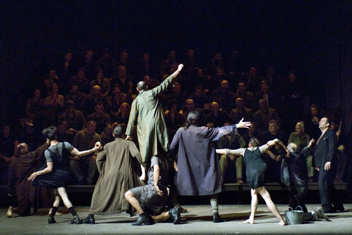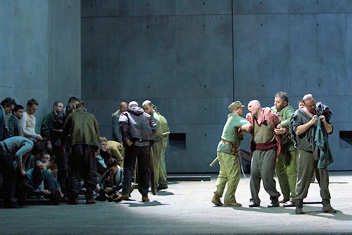|
|
|

Editorial
Board
London Editor:
(London UK)
Melanie
Eskenazi
Regional Editor:
(UK regions and Worldwide)
Bill
Kenny
Webmaster:
Bill
Kenny
Music Web Webmaster:
Len
Mullenger



|
MusicWeb is a
subscription-free site
Clicking Google adverts on our pages helps us keep it that way
Seen
and Heard International Opera Review
Janáček ,
From the House of the Dead:
Soloists,
Mahler
Chamber Orchestra, Arnold Schoenberg
Choir, Pierre Boulez (conductor) Het
Muziektheater, Amsterdam, Holland 31.
5.2007 (AO)
Cast:
Alexander Petrovič Gorjančikov : Olaf
Bär
Aljeja : Erik Stokloßa
Filka /Luka : Stefan Margita
Big convict : Peter Straka
Little convict : Vladimir Chmelo
The commandant : Jiři Sulzenko
The convict overseer : Hans Zednik
Skuratov : John Mark Ainsley
Čekunov : Jan Galla
Prostitute : Susannah Haberfeld
Šapkin : Peter Hoare
Kedril : Marian Pavlovič
Šiskov : Gerd Grochowski
Cerevin : Andreas Conrad
Director : Patrice Chéreau

Boulez
and Chéreau of course, created a now-legendary
centenary Ring cycle at Bayreuth,
which revolutionised Wagner
performance, illuminating the music
and ideas and vindicating Wieland
Wagner’s vision of what the work could
mean. Since Boulez only conducts
music he feels he can do something
special with, this Janáček performance
was clearly an event of signifigance.
It is also the first time in years
that he’s worked again with Chéreau, whom he
regards highly. The production of
From The House of the Dead, was
therefore unmissable on many counts
and although I worried beforehand that my
expectations might be too high, they
were, in fact, exceeded. Boulez and Chéreau have achieved something
truly transformational with this Janáček,
bringing out new insights and
fascinating possibilities.
Boulez has long been interested in
Janáček, having conducted all the
orchestral music and works for smaller
ensemble : though recordings don’t at
all reflect what happens in the real
world. Half a century ago, he came to
Janáček through the seminal The
Diary of One who Disappeared,
where the lines between reality and
fantasy blur. In an interview with
Pierre Audi after that performance,
Boulez spoke about what thrilled him
about the music. “Janáček adapts,” he
said “the absence of conventional
development in folk music”. Janáček
also built his music around “found
sounds”, such as the syntax of speech
and he even notated the clucking of
chickens in his garden.
Consequently, Boulez hears
surprising modernism and freshness in Janáček's muisc. Its repetitive pulse
varies through changes in rhythm, tone
and direction. This opera is
“primitive, in the best sense”, he
says in the production programme notes, “but also
extremely strong”, like the paintings
of Léger, where the “rudimentary
character allows a very vigorous kind
of expression”. Thus, there are “many
cases where you cannot find the logic
in how the rhythmic notation changes
from one ostinato to the next….so you
have to take a little freedom”.
This was an electrifying performance,
crackling with energy. Boulez builds
up swirling layers of sound in huge
blocks, out of which details flicker
past. Even in the grimness of this
Siberian gulag, Janáček’s
characteristic lyrical motifs surface,
tantalisingly. The shrill, shimmering
sections created an eerie light
against the darkness, animated by
strident blasts of brass. Boulez
captures a powerful sense of movement
in the music, so it seems to surge on
with inexorable force. This isn’t the
easiest of narratives – nothing much
happens in the plot – so the drama in
many ways “is” the music. Although I
know this opera reasonably well, from
Václav Neumann and Mackerras, Boulez’s
passionate intensity revealed many
more new levels in Janáček than I had
imagined. His is an approach almost
certainly informed by an intimate
knowledge of the composer’s other work
and its relation to modern music.

The Mahler Chamber Orchestra was
specifically created as a specialist
orchestra for chamber-like virtuosity.
It was founded by Claudio Abbado, who
chose Daniel Harding as its Music
Director in 1998. Unique in many
ways, the orchestra is fast becoming
the one of the most visionary
ensembles in Europe, highly respected
for the quality of its playing and
innovative approach. Boulez must have
had a wonderful time conducting
players of this calibre. I’ve heard
them many times and they just get
better – this really is an orchestra
to follow. There will be exciting
times ahead.
This was an approach to Janáček
that was,
“totally relevant for our time”, as
Chéreau said later in his interview
with Audi. Someone asked why he
didn’t make it into a parable about
Guantanamo Bay, for instance and he
said “No”, this is universal - orange
jumpsuits would only mute the wider
implications”. In an impish aside,
Boulez quipped “and orange is the
colour of Holland”. It’s a good
point, because a single image can
often have
multiple meanings. This production
was created with perceptive depth,
with everything in it designed to amplify
meaning. For example, the prisoners
are engaged in pointless repetitive
work – shipbuilding in Siberia, no
less. Instead of a huge construction,
which would dominate and distract, Chéreau explodes a bomb out of which
cascade streams of waste paper, which
the prisoners collect in bags. The
explosion coincides with a huge,
dramatic climax in the music, and the
“gleaning” movements in the repetitive
figures. This close integration
between music and staging reflects the
way Boulez and Chéreau work together.
From the outset, Boulez and Chereau
were both at rehearsals, so the ideas
developed with an understanding of the
full orchestral score. Actors were
used to explore the body language and
dynamic of the characters, so the
singers had more to work with when
developing their vocal approaches.
“Coherence”, said Chéreau, "between
ideas, music and drama, is the basis
of the interpretation. The eagle, for
example, is a critical symbol. It
would be easy to go for a “happy
ending” with the bird flying free, but
it would be simplistic. Rather, much
of the plot seems to pivot on the
pointlessness of destiny.
Gorjančikov is imprisoned, beaten and
freed without the least semblance of
explanation. There’s no resolution,
nothing really changes. Just as the
prisoners are toys of fate, the eagle
too, the “Tzar of the air” is a
mechanical creation, reflecting the
driving pulse of the music.
The singers seemed particularly
inspired by this visionary approach.
In this opera, there aren’t any fancy
arias, all roles being treated as
parts of a whole. Just as in a
prison, individuality is suppressed.
Each singer thus has to find something
of his own in his role and bring out a
personal signifigance. Olaf Bär’s
imposing stage presence gave
Gorjančikov a sense of importance :
we never know who he is exaclty except
that he’s a political prisoner, but
Bär’s vocal authority makes us imagine
his history. When he’s beaten and
stripped, we identify all the more
with his humiliation.
Interestingly, Boulez chose a tenor
for Aljeja, where Neumann and
Mackerras opted for a soprano. His
reason was that carefully chosen male
voices can blend subtly in the right
ensemble and that a woman in a male
role would be an unnecessary diversion
from the real issues in the plot.
Erik Stokloßa vindicates the decision,
for his deeper voice integrates well
and he’s totally convincing. When
Gorjančikov teaches Aljeja to read, we
hear a delightful freshness infuse
Stokloßa’s singing, enhancing the
“springtime” melody so typical of the
composer. The acting here, perhaps
inspired by the thought and effort put
into the portrayals, was superlative.
John Mark Ainsley in white makeup,
dressed like a corpse in a torn
shroud, risen from the grave, laughed
maniacally as Luka dies, and Aljeja
suffers. It was horribly gruesome yet
completely apt.
Janáček’s “speech melodies” matter
more than usual in this stark,
unadorned opera, and in this
production, the sharpness of diction
and syntax in the singing captured the
craggy, angular idiosyncrasies in the
music perfectly. The refrains “Hou,
hou, hou ! “, and “Chi, chi, chi !”
and even “Ach…ach….ach !” function as
if they were abstract parts of the
orchestration.
Yet, as Chéreau points out, what
really pervades the opera for him is
its implicit humanity. Under the
harshness and violence a sense of
“compassion”, as he puts it, flows
surprisingly strongly and
runs like a hidden stream throughout
the opera, surfacing at critical
junctures. It is also totally
non-judgemental. Neither murderers
nor guards are held to account, they
simply exist. The famous phrase near
the end, “he too was born of a mother”
seems to pervade the narrative long
before it is actually uttered. This
performance touched on something quite
fundamental embedded beneath the harsh
angularity and “primitiveness” of the
score, such was the intelligence and
understanding that went into its
conception. The underlying warmth
showed in the passion of the
orchestral playing too so that the
whole production cohered as music and
drama.
The production continues through July
in Aix en Provence and at La Scala in
Milan. It will also move to New York,
but with Eska-Pekka Salonen conducting
in place of Boulez. Hopefully, it
may be preserved on film, like the
excellent Audi Ring Cycle, filmed in
this very same theatre a few years
ago. It certainly deserves to reach a
wider audience than the lucky few who
can attend. Absolutely, this is not
one to miss.
Anne
Ozorio
Pictures
© Ros Ribas
For
more on this exciting orchestra,
please see :
http://www.mahler-chamber.de/main.php?entree=ensemble
Back
to the Top
Back to the Index Page
|
Seen and Heard, one of the longest established live
music review web sites on the Internet, publishes original reviews
of recitals, concerts and opera performances from the UK and internationally.
We update often, and sometimes daily, to bring you fast reviews,
each of which offers a breadth of knowledge and attention to performance
detail that is sometimes difficult for readers to find elsewhere.
Seen and Heard
publishes interviews with musicians, musicologists and directors
which feature both established artists and lesser known performers.
We also feature articles on the classical music industry and we
use other arts media to connect between music and culture in its
widest terms.
Seen and Heard
aims to present the best in new criticism from writers with a radical
viewpoint and welcomes contributions from all nations. If you would
like to find out more email Regional
Editor Bill Kenny. |
|
| |
|
Contributors: Marc
Bridle, Martin Anderson, Patrick Burnson, Frank Cadenhead, Colin
Clarke, Paul Conway, Geoff Diggines, Sarah Dunlop, Evan Dickerson
Melanie Eskenazi (London Editor) Robert J Farr, Abigail Frymann,
Göran Forsling, Simon Hewitt-Jones, Bruce Hodges,Tim Hodgkinson,
Martin Hoyle, Bernard Jacobson, Tristan Jakob-Hoff, Ben Killeen,
Bill Kenny (Regional Editor), Ian Lace, John Leeman, Sue Loder,Jean
Martin, Neil McGowan, Bettina Mara, Robin Mitchell-Boyask, Simon
Morgan, Aline Nassif, Anne Ozorio, Ian Pace, John Phillips,
Jim Pritchard, John Quinn, Peter Quantrill, Alex Russell, Paul
Serotsky, Harvey Steiman, Christopher Thomas, Raymond Walker, John Warnaby,
Hans-Theodor Wolhfahrt, Peter Grahame Woolf (Founder & Emeritus
Editor)
|
Site design: Bill Kenny
2004 |

